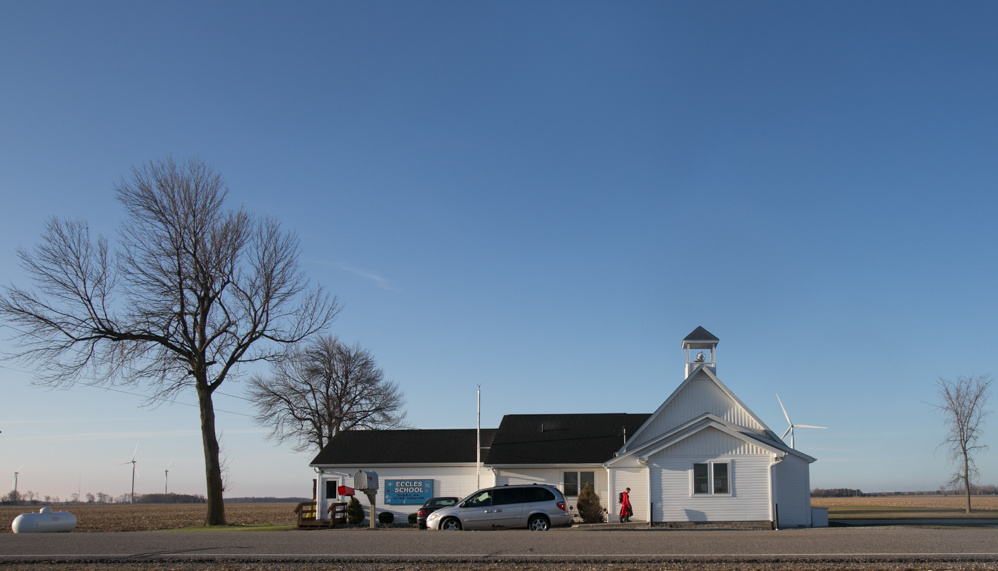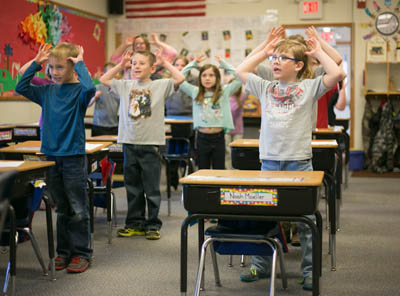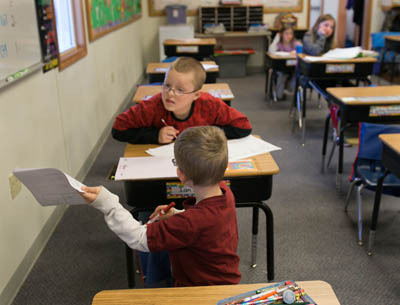Michigan’s one-room schoolhouses make one last stand


SLIDESHOW: Images from an education in one room
HARBOR BEACH ‒ Most elementary and middle schools fairly buzz with noise just before the school day starts, as a stampede of students put away coats, take seats and share boasts over video game exploits or exchange giggles about young romance.
But one of the first things you notice at the Eccles School along a rural stretch of Michigan’s Thumb is a quiet shuffle as students move from door to desk to computer station, creating a low-level hum until the Pledge of Allegiance. After which, there’s an exchange of news about soccer, a puppy and one student’s gig as bat boy for a minor league baseball team nearly two hours away.
The second thing you notice at Eccles, and what sets it apart from most classrooms, are the desks. They’re adjustable. Which you need when an eighth grader sits next to her first-grade sister. Where a single classroom holds 20 students from kindergarten through 8th grade.
Here in Huron County sits Eccles School, which is at once a classroom, a school and its own kindergarten-8th grade district, known formally as the Sigel Township #3F School District.
Located in the shadow of giant wind turbines and thousands of acres of farmland, it is an anachronistic nod to the past, one of six one-room school houses in Huron County and one of 16 in the Lower Peninsula with a total student population of 488 last fall, or just over 32 students per school. (There are seven one-room school districts in sparsely populated areas of the Upper Peninsula, but what makes the 16 in lower Michigan unique is their proximity to larger, more traditional public school districts).
They are remnants of a system that has its roots in the founding of the Midwest and the Northwest Ordinance of the late 18th Century, which dedicated township land for local school districts. An estimated 200,000 school districts existed in the United States around 1900, many one-room schoolhouses; by 2010, the number of school districts had dwindled to roughly 15,000 following waves of consolidation. There are now thought to be fewer than 400 one-room schools in the U.S.
These buildings harken back to the days when necessity and distance required one-room schoolhouses and a single teacher to educate local children of all ages. Today, despite the ubiquity of cable, smartphones, Instagram and Twitter, teens at Eccles get a taste of the 19th Century, sharing a classroom and lunch, recess and field trips with younger schoolchildren. It’s where a teacher, perhaps with an assistant, must master all subjects at nine grade levels – and where the oldest students are leaned upon to help teach the youngest.
“This is the world we live in every day and I love it,” said Anne Kennedy, who has taught at Eccles for 25 years, the maestro of a daily symphony of learning that for many Michigan parents may seem crazy. Though she has help from a full-time aide and traveling art and music teachers, Kennedy is an algebra teacher and basic reading instructor, principal and janitor.
Eccles and its tiny kin around the state are a link to a style of education that has died across much of the United States. In neighboring Ohio, for instance, no public school district has fewer than 250 kids; in Indiana, the smallest district has 240 students.
Bucking consolidation
But in Michigan, these micro districts remain and are another piece in a complicated education pie. There are 30 districts in the state with fewer than 100 students and 48 with fewer than 250, including three island districts in lakes Huron and Michigan.
MORE COVERAGE: Four siblings, a single classroom
They have survived despite calls by Gov. Rick Snyder for the consolidation of government services, which he encouraged – but did not demand – with the carrot of additional state grant money.
“It’s one more choice that’s out there,” said Joseph Murphy, superintendent of the Huron Intermediate School Districts, which includes the six one-building school houses in the county averaging about 20 students each, a sliver of the more than 4,300 public school children across Huron County.
Though the state continues to encourage districts to consolidate through the promise of financial help, these small districts have often declined the offer.
Elsewhere, the state has not been shy about forcing larger school districts to close over long-term deficits; for example, in Buena Vista and Inkster were dissolved in 2013. But these tiny school districts appear to be in fine fiscal shape; none is in deficit, according to state records.
Not all small districts are staying pat. Just this month, voters in Ionia County approved plans to annex Palo Community Schools – with 75 students when it began to wind down two years ago – into neighboring Carson City-Crystal Area schools. In July, the Port Hope Community Schools, a K-12 district in eastern Huron County with 72 kids two years ago, completes its annexation into the North Huron district.
Yet many of these mini K-8 districts, perhaps the most ripe for consolidation and annexation, continue to survive, attracting students whose parents are choosing schools that provide an intimate classroom for students of all ages and a single teacher.
“Country schools are thriving in the 21st Century,” said Andrew Gulliford, a history professor at Fort Lewis College in Colorado and author of a respected book on the history of one-room schools in the United States.
Charter schools around the country are adopting the multi-age, single-room model, he said, bucking the decades long trend to separate students and create larger schools What the parents are seeking are the rewards both he and advocates in Michigan say come with a one-room school education.
“Out of isolation comes a sense of identity, a stronger character and stronger sense of self and I think parents want that,” Gulliford said.
Parental choice
Simply put, if weren’t for those parents, who are choosing Eccles and its siblings over larger established districts, the K-8s would be dead and its leaders know it.
“I don’t know how long we can hang on and keep the little districts and the K-8s open,” said Julie Talaski, who coordinates services for the six one-room Huron County schools – and is on the Eccles board. She knows school choice in Michigan has provided a lifeline to these schools.
Of the 117 students being educated this year at the six Huron County rural schools, 98 live in other districts. Similarly, 79 percent of the nearly 450 students in the 16 one-room school houses across the lower peninsula come from outside districts – bringing with them their state per-pupil education dollars that allow the small schools to survive.
Eccles, a white, wood-frame building with a bell cupola, opened in 1886 and has been added on to twice. All but one of the school’s 20 students come from outside the district, far different than when Kennedy started teaching at Eccles 25 years ago. Back then, she had just seven students. She’s seen as many as 29. Enrollment could rise next year, she said, with the addition of three kindergartners.
That means Eccles is doing something right because people with options are choosing the school. They could send their kids to Bad Axe, enrollment 1,070, or Harbor Beach, enrollment 575. Or one of the other K-8 one-room school districts in the county.
Although its students’ MEAP scores are not publicly available because the school is so small, Eccles was given a “green” code – the highest possible – on the state’s school accountability report, which includes MEAP test scores and other measures, including attendance and teacher effectiveness.
“There’s almost a nostalgia about them,” said Don Wotruba, deputy director of the Michigan Association of School Boards, said of schools like Eccles.He said he’s heard no one talk about making changes, like forcing consolidation, with the state’s smallest districts. “If that’s something that a family wants to choose, why would be we bother with that?”
Academic challenges
Education experts would pose two possible reasons: Are they cost effective? And are they effectively educating students?
On the first count, the schools appear to pass the test. Records show they spend roughly the same per-pupil as nearby larger districts, often less. Kennedy makes a decent salary, over $67,000 according to state records, but she doesn’t get health insurance. None of the 16 one-room districts is in deficit, according to the state.
As for student performance, that’s harder to measure. The state can close districts for financial reasons. But it’s ability to challenge a district over poor student performance is limited and most of the one-room schools don’t have enough students to qualify for the same kind of public scrutiny of their academic performance (The Michigan Department of Education refused to make anyone available to talk to Bridge about accountability at one-room schools).
Because there are so few students in each grade, most district-wide MEAP test scores aren’t public because the law prevents disclosure if fewer than 10 kids are in a class for student privacy reasons.
That means most of the one-room districts do not appear on state performance rankings, which determine whether they are performing well enough to avoid oversight. Only two of the 16 districts – both in Berrien County – had enough students to get on the list. (River School was in the 60th percentile of schools statewide in 2013-14, while Riverside School performed below the state average, ranking in the 38th percentile.)
Some question why these one-room schools are not held publicly accountable for their performance on the MEAP as well (The MEAP has been replaced this year by another test).
“If we are going to be judged on an assessment, we should all be judged,” said Pat Batista, superintendent of the Ionia Public Schools. “All means all.”
But while the state doesn’t release MEAP scores for the smallest districts, including the three in Ionia County, it does give a glimpse into student performance through it’s “academic dashboard,” which combines the performance on the MEAP in grades 3-8 in reading and math and overall student growth. (Because the dashboard combines grades, there are enough students to disclose results.)
Across Ionia County, just over one-third of all 3-8 graders (in schools large and small) were deemed proficient in math and reading in 2013-14. At the K-8 Coon School and Haynor School – the two one-room schools in Ionia large enough to have their test data publicly released – only 12 percent of 3-8 graders met proficiency standards in math and reading.
Bob Kjolhede, superintendent of the Ionia Intermediate School District, which provides service to districts in the county, said he’s heard from the administrators of the larger K-12 districts who question the performance of the tiny districts. “They get those students and all those (academic) gaps that come with them.”
Though Batista said she doesn’t have statistics on the students who enter Ionia High School after attending one-room schools, Kjolhede said others have told him that some of the students come to high school needing help in science, social studies and English.
He said it’s the likely result at a school where one teacher may have to prepare for 16 different subject/grade levels a day. “It’s an almost impossible job to do,” he said.
The teacher’s task can be daunting. They are asked to become experts in every subject at every grade level. They must help young students learn the foundations of math or science while keeping older student’s challenged with more complex lessons.
“You must be an incredible generalist,” Gulliford said, “and your goal at the same time is to challenge the really smart kid to get them to skip a grade.”
And unlike teachers in more traditional schools, teachers in one-room schools don’t have a principal or more experienced colleagues nearby to turn to for help or support.
“I don’t know how they do it,” Kjolhede said.
Facing the challenge
But at Eccles, Kennedy appears to be doing just fine. Although it’s grade-by-grade scores are not available because of Eccles’s size, the state “academic dashboard” shows the school has overall proficiency rates above the Huron County average.
On a recent morning, three second graders sat with teacher’s aide Amy Crandall going over a spelling and reading assignment. Each read the instructions aloud effortlessly.
Meanwhile, another student was up at Kennedy’s desk. The remaining students worked silently at their desks on homework or reading, waiting for their turn with the teacher. In one two-hour stretch, Kennedy would lead different groups in 5th grade math, 7-8th grade algebra, 6th grade math, 4th grade science, 2nd grade math and 7-8th grade pre-algebra again.
If a younger student not at her desk needs help, he or she can lean on one of the older kids, who willingly oblige.
Scott Grekowicz, 22, looks back at this days at Eccles with fondness. Now a senior in chemical engineering at the University of Toledo, Grekowicz was one of those who asked for help as a kid and then gave it as a teen. He went on to become valedictorian of Harbor Beach High School, something that several Eccles students have done, Grekowicz, Talaski and Kennedy said.
Helping others made him a leader, he said, having independence gave him confidence. There was no bullying, no cliques. “It really is a little family,” he said.
In a school so small, Grekowicz didn’t have to deal with much teen drama. Though he had seven kids in his grade, there were no unpleasant social issues, he said.
For Crandall, the teacher’s aide, that’s one of the appeals of the small schools. When music teacher Lisa Keim, who travels among all six of Huron County’s tiny rural schools, came in to work on the school music program, the eldest and the youngest students all joined in to sing the Disney song “It’s a Small World After All.” Together.
“It’s that innocence that they’re allowed to keep longer,” Crandall said. “They’re not pushed into peer pressure. Their sense of self is so strong.”
Multitask or perish
Just a few miles away is the even smaller Kipper School, set in a steep-roofed rectangular building little changed since it opened in 1907, with just 10 students. It’s where teacher Brad Fewins keeps the plates in the air, teaching 6th grader Becca Welther about probability and odds as others work silently – or sort of silently.
As Fewins works with Becca he spies a problem and quickly addresses it. “Steven? Whispers only,” he says to a young student before returning to Becca. He has to get on Steven again a few minutes later but always returns to Becca.
“You’re learning to multi-task very well,” he said during a short break. Coming out of Grand Valley State University, Fewins, 28, said he expected to be a math teacher. He is – but he is also an English, social studies and science teacher.
And he’s now learning what no one prepared him for in education school – working one-on-one with almost every student, every day, on every subject. At Eccles and Kipper and elsewhere, the teacher knows instantly when the student’s look goes vacant, when the light bulb dims, Fewins said. It’s when they know they have to back up.
“I always make sure they have the skill before they move on,” Fewins said.
An uncertain future
If it can work at Eccles and Kipper, could it work elsewhere? Would the state agree to the creation of more one-room school houses? Would people choose it if they could?
Perhaps, but to build smaller schools in an urban setting could be cost prohibitive, said Carol Tomlinson, an education professor at the University of Virginia. Educators have taken pieces of the country-school model to heart: having blended classrooms, allowing students to learn at their pace. But that movement has waned with the increasing demands of grade-level standardized testing, she said.
And not every educator would work without healthcare or lower pay, or without a principal and a staff to share the burden. Maybe it only works when the students are part of a connected school community.
At Kipper, the lone 8th grader is Alyssa Guza, a confident teenager who, like Grekowicz, has helped teach her younger classmates. She knows there are bigger schools with more people her age, but that’s okay. “I never minded. It’s just kind of how it was,” she said. And she says she has benefitted: “You get a lot of one-on-one attention.”
Then there’s lineage: Alyssa’s dad Steve is on the Kipper school board. He went to Kipper. It’s who they are. And it’s that way around the county: Anne Kennedy, the teacher at Eccles went to a now-closed, one-room school in Huron County; her sister brings her son to Eccles.
But most know that their schools could one day fall to the same fate as those former buildings you see all over Michigan: A bell on top, at the corner of two main roads, out in the country. Maybe it’s an antique store now, or a church or a home. Perhaps it’s just empty.
If that should happen to these schools, disappearing like those in Ohio and Indiana decades ago, there will be many mourning the loss. Like she does every year as eighth graders graduate, Anne Kennedy would expect tears.
“It’ll be sad to see the end,” she said
SLIDESHOW: A Sample of one-room schoolhouses in the lower peninsula
See what new members are saying about why they donated to Bridge Michigan:
- “In order for this information to be accurate and unbiased it must be underwritten by its readers, not by special interests.” - Larry S.
- “Not many other media sources report on the topics Bridge does.” - Susan B.
- “Your journalism is outstanding and rare these days.” - Mark S.
If you want to ensure the future of nonpartisan, nonprofit Michigan journalism, please become a member today. You, too, will be asked why you donated and maybe we'll feature your quote next time!
 Eccles School in Harbor Beach is one of six one-room schoolhouses in rural Huron County in Michigan’s Thumb. All but one of its 20 students come by choice from outside the district. (Bridge photo by Brian Widdis)
Eccles School in Harbor Beach is one of six one-room schoolhouses in rural Huron County in Michigan’s Thumb. All but one of its 20 students come by choice from outside the district. (Bridge photo by Brian Widdis) Farmland surrounding Kipper Elementary School in Harbor Beach provides lots of room to run during recess. Kipper has one teacher and one paraprofessional for 11 students in kindergarten through 8th grade. (Bridge photo by Brian Widdis)
Farmland surrounding Kipper Elementary School in Harbor Beach provides lots of room to run during recess. Kipper has one teacher and one paraprofessional for 11 students in kindergarten through 8th grade. (Bridge photo by Brian Widdis) Morning recess at the Eccles School offers opportunity for a quick game of dodgeball ‒ til the bell rings. And it's a real bell. (Bridge photo by Mike Wilkinson)
Morning recess at the Eccles School offers opportunity for a quick game of dodgeball ‒ til the bell rings. And it's a real bell. (Bridge photo by Mike Wilkinson) Young and old belt out a song. At Eccles, 1st grader Mason Ramsey, front left, and kindergartner Noah Moeller, front right, with older classmates behind them. (Bridge photo by Brian Widdis)
Young and old belt out a song. At Eccles, 1st grader Mason Ramsey, front left, and kindergartner Noah Moeller, front right, with older classmates behind them. (Bridge photo by Brian Widdis) In a classroom teaching kindergarteners to 8th graders, older students are called on to help younger kids with lessons. At the Eccles Schools, Ian Morley, top, in 4th grade, helps kindergartner Conner Woodchisky check his classwork (Bridge photo by Brian Widdis)
In a classroom teaching kindergarteners to 8th graders, older students are called on to help younger kids with lessons. At the Eccles Schools, Ian Morley, top, in 4th grade, helps kindergartner Conner Woodchisky check his classwork (Bridge photo by Brian Widdis)